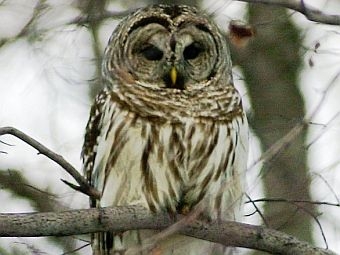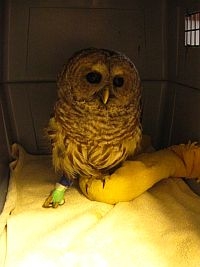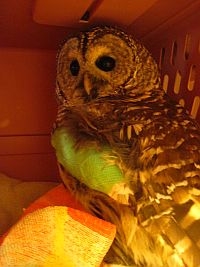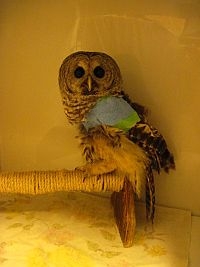
This winter’s record-breaking snow has taken a toll on our roads and our roofs. But we humans aren’t the only ones having a hard time. Vermont’s Barred Owls are struggling to hunt prey under the deep snow pack. So the nocturnal hunters are getting creative – and showing up in unexpected places.
VPR’s Angela Evancie reports:
(Evancie) Sue Wetmore of Brandon is an avid birder. She’s also a photographer – and this year, her album is full of photos of barred owls.
(Wetmore) "So we hit Charlotte, uh, yeah, this was in Charlotte. So we had that owl, then we got to Leicester and we had two more that same day. We had three owls in one day!"
(Evancie) Wetmore waits until the perfect moment to photograph the owls. She saw one a few weeks ago in Brandon.
(Wetmore) "But the owl was sitting in the shade. So I just kept walking up towards him. And finally it just jumped from the shade into the sun, and I got my picture."
(Evancie) The words "sun" and "barred owl" don’t usually go together. The owls are nocturnal, and hunt under the cover of night. But this winter, daytime sightings are on the rise.
(Elliot) "Without particularly going to look for them I have seen them probably on five or six occasions."
(Evancie) That’s Sue Elliot, another birder. She lives in Rutland, but she hasn’t had to go far to spot an owl. In fact, she and her husband, Marv, spent a whole day watching an owl feast on a rabbit – from their kitchen window.
(Elliot) "It was gone the next morning, but Sunday afternoon, round mid-afternoon again, it was back. There was still quite a bit of rabbit left."
(Evancie) Chris Rimmer is the director of the Vermont Center for Ecostudies. He says barred owl sightings become more common when the birds are desperate for food.
(Rimmer) "Due to the harsh winter we’ve had, with a very heavy snow pack, and more recently some icing over, it’s become much more difficult for these owls to hunt."
(Evancie) That’s because the rodents that owls hunt move underneath the snow. When the snow is deep and layered with ice, the owls can’t break through.
(Rimmer) "So they are food stressed, which takes them outside of their comfort zone to places where they may find more concentrated food, which could be near birdfeeders, along roadways where the rodents have to cross."
(Evancie) This may mean more viewings, but it puts the owls at risk. Owls that dive down for prey on the road often get hit. If they survive, they end up at the Vermont Institute of Natural Science, or VINS, in Quechee.
[Sound of door opening.]
(Oliver) "This is our intensive care area…"
(Evancie) Meghan Oliver is the wildlife services manager at VINS. She’s in charge of rehabilitating owls that arrive with head trauma and broken bones.
(Oliver) "This is one of our owls right here…"
(Evancie) Some of the owls in the ICU are alert. They look you right in the eye and click their beaks loudly. Others look woozy and depressed.
(Oliver) "Here’s another example of an owl that’s a little bit out of it still. You can see his eyes are not fully open and bright, and he’s blinking slowly and he’s not sitting on his perch. So he seems a little bit, you know, he’s still out of it basically."
(Evancie) VINS has received thirty-nine barred owls so far this winter, and counting. That’s up from just fourteen last winter. Oliver says there’s one thing Vermonters can do to keep owls away from the roads: Stop tossing apple cores out the car window. The food attracts rodents, and the owls aren’t far behind.
(Oliver) "We would love it if people stopped throwing food out their car windows…Save a lot of owls."
For VPR News, I’m Angela Evancie.
You can report any Barred Owl viewings on a database called eBird, whose Vermont information is coordinated by the Vermont Center for Ecostudies. If you see a Barred Owl in distress, please contact the Vermont Institute of Natural Sciences.



Photos courtesy of Meghan Oliver at VINS